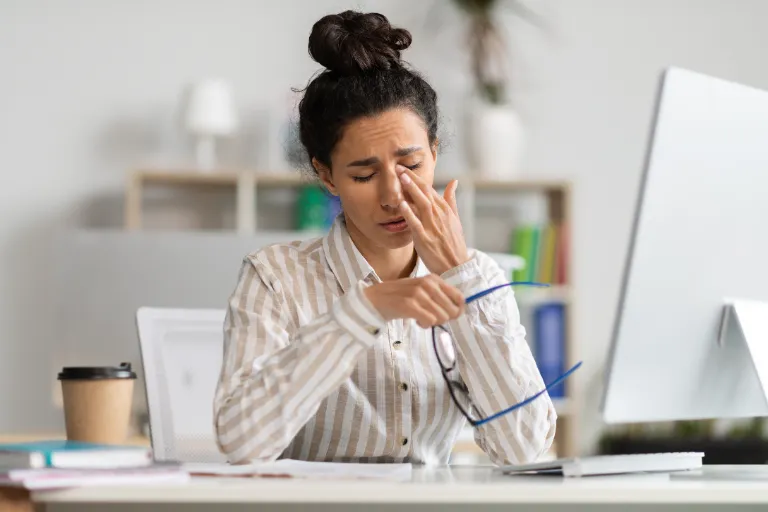Key Points
- Digital eye strain is now one of the most common side effects of prolonged screen use, affecting over half of U.S. adults.
- Symptoms include blurred vision, dryness, headaches, and difficulty focusing.
- Main causes: reduced blinking, poor ergonomics, screen glare, and extended focus without breaks.
- Evidence shows screens don’t cause permanent damage, but chronic discomfort can affect productivity and wellbeing.
- Practical solutions include the 20-20-20 rule, ergonomic adjustments, artificial tears, and emerging blue-light filtering technologies.
Why Our Eyes Feel the Strain in a Screen-Saturated World
Have your eyes ever felt gritty, tired, or heavy after a long day of work on your laptop? You’re not alone. Studies suggest that more than 50% of computer users worldwide experience digital eye strain after extended screen time [1]. As daily life has shifted online—from Zoom calls to streaming entertainment—our eyes are bearing the brunt.
What makes this more than just an inconvenience is its growing reach. Children in classrooms, professionals on back-to-back video calls, and older adults managing health apps are all reporting the same discomfort. Digital strain has quietly become one of the most universal side effects of modern life, and understanding it is the first step to protecting long-term visual comfort.
Why Digital Eye Strain Matters More Than Ever
What was once an occasional complaint among office workers has now become a near-universal symptom in the digital age. Children, students, professionals, and retirees alike spend unprecedented hours on screens. According to recent surveys, U.S. adults average over seven hours of screen time per day, and that figure climbs even higher among younger generations [2].
Ignoring eye strain doesn’t just mean tolerating discomfort—it can affect productivity, sleep quality, and overall health. In some cases, untreated vision issues (like uncorrected farsightedness) can worsen symptoms, making digital strain harder to manage.
Recognizing the Warning Signs of Digital Eye Strain
Digital eye strain—sometimes called computer vision syndrome—presents in multiple ways:
- Dryness or irritation – from reduced blinking and tear film instability.
- Blurred or double vision – after prolonged near-focus.
- Headaches and eye fatigue – from constant refocusing.
- Neck and shoulder pain – often linked to posture and screen angle.
While symptoms usually resolve with rest, chronic exposure without adjustments can make these flare-ups daily occurrences. Many users also report difficulty concentrating or feeling mentally drained after hours of screen use—symptoms that can ripple into workplace efficiency and mood.
The Science Behind Eye Fatigue: How Screens Affect Vision
The mechanisms are surprisingly straightforward. When staring at screens:
- Blinking slows down – from around 15–20 blinks per minute to as few as 5–7, reducing lubrication and causing dryness [3].
- Near-focusing muscles work overtime – leading to fatigue and blurred vision.
- Glare and blue light – while not damaging to the eye, can add to discomfort and disrupt circadian rhythms [4].
Importantly, evidence shows screens do not cause permanent eye damage—a common misconception—but they do stress the visual system in ways that can be managed with awareness and preventive habits [5].
Practical Ways to Protect Your Eyes in the Digital Era
Protecting your vision doesn’t mean giving up screens—it’s about balance.
1. Follow the 20-20-20 Rule
Every 20 minutes, look at something 20 feet away for at least 20 seconds. This resets focusing muscles and reduces fatigue.
2. Optimize Your Workstation for Eye Comfort
- Keep screens at arm’s length, slightly below eye level.
- Reduce glare by adjusting lighting or using an anti-glare filter.
- Maintain proper posture to prevent neck and shoulder strain.
3. Keep Your Eyes Hydrated and Rested
Artificial tears can help combat dryness, especially in air-conditioned or heated environments. Remember to blink more consciously during long work sessions.
4. Rethink Blue-Light Exposure
While blue light doesn’t cause eye disease, evening exposure may affect sleep. Using night mode on devices or blue-light filtering glasses can reduce disruption.
5. Explore New Tech and Digital Wellness Tools
New display technologies—such as e-ink monitors, high-refresh-rate screens, and adaptive brightness systems—are being designed to minimize strain. Eye health apps and wearable devices that prompt breaks are also gaining traction.
When to Seek Help and How to Build Healthier Digital Habits
If eye strain persists even after adjustments, it may signal uncorrected vision issues. A comprehensive exam with a licensed eye care professional can rule out underlying problems. Many people are surprised to discover that even a minor prescription update can significantly reduce strain during computer work.
In the meantime, building small habits—like scheduling breaks, staying hydrated, and optimizing your digital environment—can go a long way. Think of these adjustments not as restrictions, but as investments in long-term eye comfort. The more mindful you are about your screen habits, the easier it becomes to integrate sustainable solutions into everyday life.
Finding Balance in a Digital Age
Digital eye strain is the price many of us pay for life in front of screens, but it doesn’t have to be inevitable. With small, evidence-based adjustments, you can reduce discomfort, preserve productivity, and protect your vision health. The key is awareness: listen to your body, give your eyes breaks, and embrace emerging tools that support digital balance.
The article does not in any way constitute as medical advice. Please seek consultation with a licensed medical professional before starting any treatment. This website may receive commissions from the links or products mentioned in this article.
Subscribe for Free for more insightful health articles tailored to your needs.
Sources
[1] American Optometric Association. Computer Vision Syndrome (Digital Eye Strain).
[2] Statista. Average daily screen time among adults in the United States.
[3] Sheppard, A. L., & Wolffsohn, J. S. (2018). Digital eye strain: prevalence, measurement and amelioration. BMJ Open Ophthalmology.
[4] Harvard Health Publishing. Blue light has a dark side.
[5] American Academy of Ophthalmology. Does digital screen time permanently damage your eyes?




